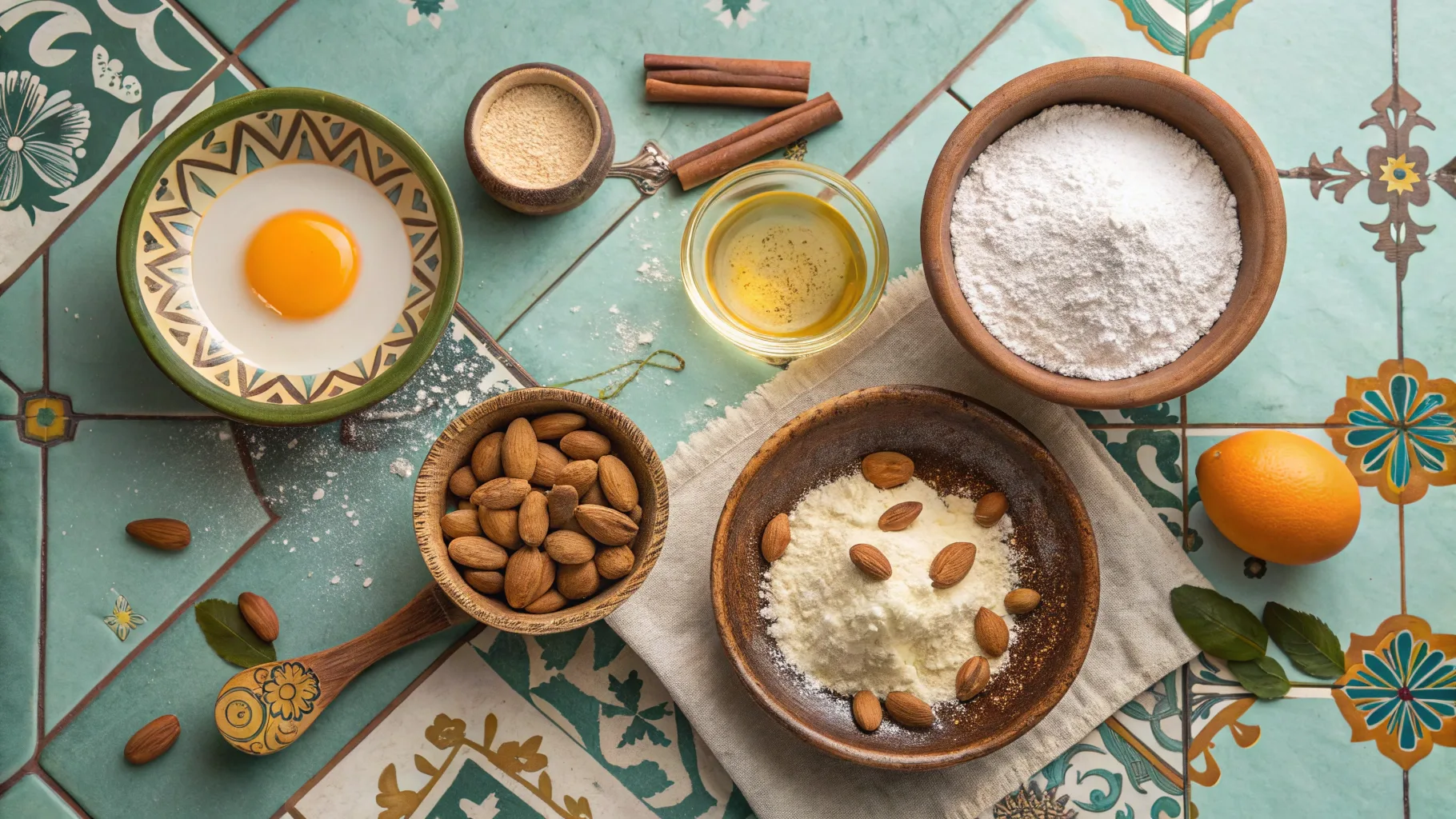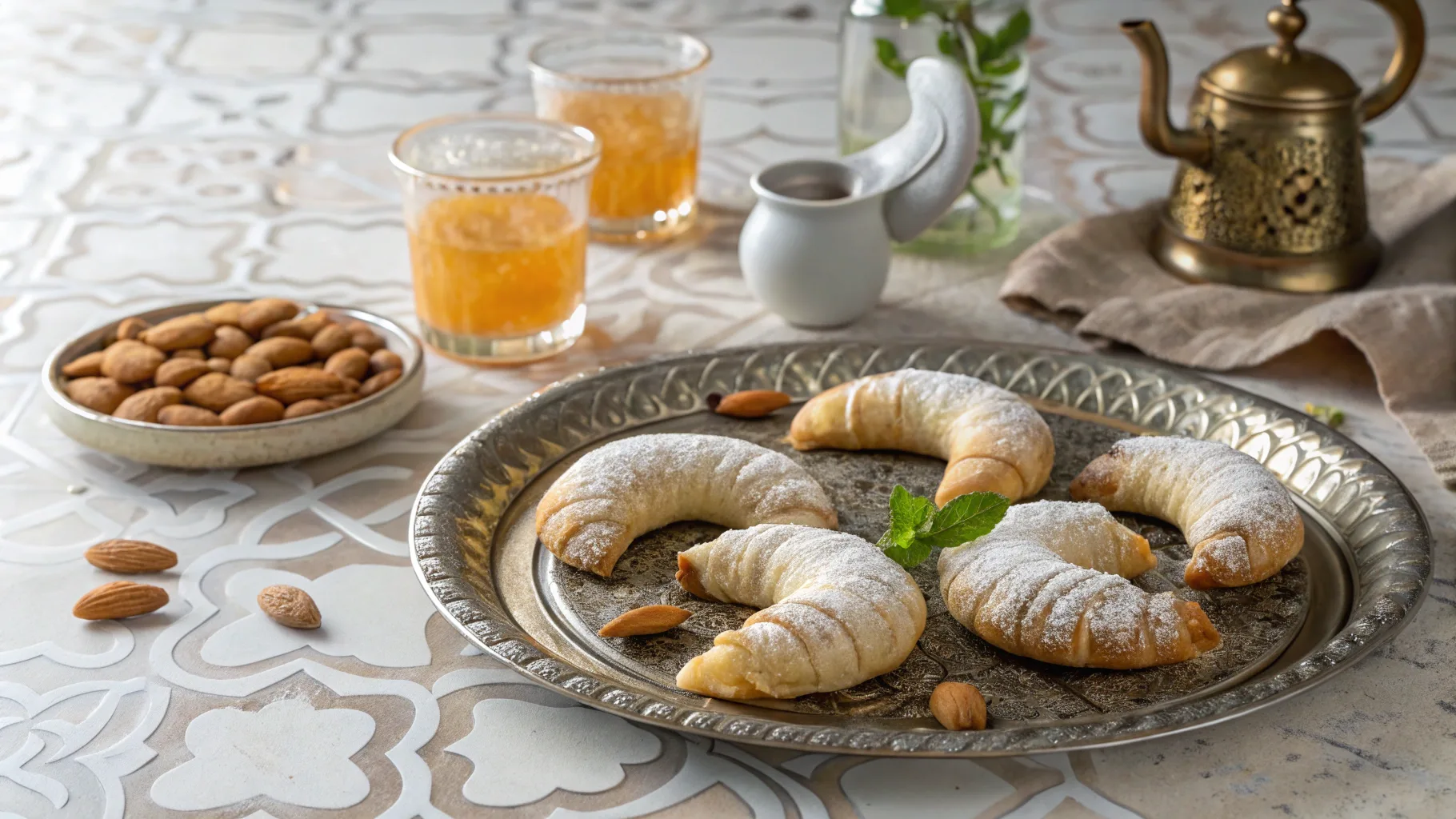Picture this: You’re standing in your kitchen, surrounded by the heavenly fragrance of orange blossom water mingling with toasted almonds. Your hands are dusted with flour, and before you lie dozens of perfectly crescent-shaped pastries, golden and gleaming like precious treasures. This isn’t just baking – this is your gateway to mastering one of Morocco’s most cherished culinary secrets.
Kaab el Ghazal, literally meaning “gazelle horns,” represents centuries of Moroccan pastry artistry. These delicate crescents have graced royal tables, celebrated weddings, and brought families together during special occasions. Today, you’ll discover how to recreate this authentic experience in your own kitchen, transforming simple ingredients into something truly extraordinary.
What Makes Kaab el Ghazal So Special?
These aren’t ordinary cookies. Each gazelle horn tells a story of Morocco’s rich culinary heritage, where precision meets passion in every fold. The name itself comes from their distinctive curved shape, resembling the graceful horns of gazelles that once roamed the Atlas Mountains.
Traditional Moroccan families prepare these delicacies during significant celebrations – from Eid festivities to wedding ceremonies. The paper-thin pastry encases a fragrant almond filling that melts on your tongue, creating an unforgettable sensory experience that connects you directly to North African tradition.
Essential Ingredients for Authentic Gazelle Horns
Your success depends on gathering the right ingredients. Here’s what you’ll need to create approximately 25-30 perfect pastries:
For the Almond Filling:

| Ingredient | Amount | Purpose |
|---|---|---|
| Blanched almonds | 2 cups | Core flavor base |
| Powdered sugar | 1/2 cup | Natural sweetness |
| Orange blossom water | 2 tablespoons | Authentic aroma |
| Egg white | 1 large | Binding agent |
| Ground cinnamon | 1/4 teaspoon | Warm spice note |
For the Pastry Dough:
| Ingredient | Amount | Purpose |
|---|---|---|
| All-purpose flour | 2 cups | Structure foundation |
| Butter, softened | 3 tablespoons | Tenderness |
| Vegetable oil | 2 tablespoons | Flexibility |
| Orange blossom water | 1 tablespoon | Flavor enhancement |
| Salt | 1/4 teaspoon | Flavor balance |
| Warm water | 1/3 cup | Dough consistency |
Step-by-Step Guide: How to Make Moroccan Kaab el Ghazal
Step 1: Preparing Your Almond Filling (20 minutes)
Begin by blanching your almonds if they aren’t already prepared. Submerge them in boiling water for 60 seconds, then immediately transfer to ice water. The skins will slip off effortlessly, leaving you with pristine white almonds.
Using a food processor, pulse the blanched almonds until they form a fine powder. Avoid over-processing, which creates almond butter instead of the desired texture. Add powdered sugar, cinnamon, and orange blossom water, then incorporate the egg white gradually until the mixture holds together when pressed.
The perfect filling should feel slightly moist but not sticky. If it’s too dry, add orange blossom water drop by drop. Too wet? Incorporate more ground almonds. Set this aromatic mixture aside while you prepare the dough.
Step 2: Creating the Perfect Pastry Dough (15 minutes)
In a large mixing bowl, combine flour and salt. Create a well in the center and add softened butter, vegetable oil, and orange blossom water. Using your fingertips, gradually incorporate the flour into the wet ingredients.
Slowly add warm water, mixing until a soft dough forms. The texture should be smooth and pliable, not sticky or dry. Knead gently for 2-3 minutes until the dough becomes elastic and springs back when touched.
Wrap your dough in plastic wrap and let it rest for 30 minutes at room temperature. This resting period allows the gluten to relax, making the dough easier to roll paper-thin.
Step 3: Mastering the Rolling and Shaping Technique (30 minutes)
This step requires patience and practice. Divide your rested dough into walnut-sized portions. On a lightly floured surface, roll each piece into an ultra-thin circle, approximately 4 inches in diameter. You should almost be able to see through the dough.
Place a teaspoon of almond filling along one edge of each circle, leaving borders clear. Carefully roll the dough around the filling, creating a tight cylinder. Then, gently curve the cylinder into a crescent shape, resembling a gazelle’s horn.
Seal the edges by pressing lightly with your fingertips or a fork. Each pastry should be uniform in size and shape for even baking.
Step 4: Proper Baking Methods for Golden Perfection (12-15 minutes)
Preheat your oven to 350°F (175°C). Line baking sheets with parchment paper to prevent sticking. Arrange your shaped pastries with adequate spacing – they’ll expand slightly during baking.
Bake for 12-15 minutes, rotating the pans halfway through for even browning. The pastries are ready when they turn pale golden and feel firm to the touch. Avoid overbaking, which creates a tough texture.
Step 5: Final Touches and Presentation (10 minutes)
Allow your gazelle horns to cool completely on wire racks. Once cooled, dust them generously with powdered sugar using a fine-mesh sieve. This creates the traditional white coating that makes them visually stunning.
Store in airtight containers at room temperature for up to one week, though they’re best enjoyed within the first few days when the texture remains perfectly crisp.
Expert Tips for Perfecting Your Technique
Avoiding Common Mistakes
Many home bakers struggle with these particular challenges:
- Thick dough: Roll gradually in multiple passes rather than forcing thinness
- Filling leakage: Don’t overfill, and ensure edges are properly sealed
- Uneven shapes: Practice makes perfect – your technique will improve with repetition
- Tough texture: Handle the dough gently and avoid overworking
Professional Secrets
Temperature control is crucial throughout the process. Keep your workspace cool, especially during humid weather. If the dough becomes too soft to handle, refrigerate it for 15 minutes before continuing.
The filling consistency should hold together when squeezed but not be wet enough to make the pastry soggy. Test a small batch first to perfect your technique before making the full recipe.
Nutritional Benefits and Cultural Significance
Each gazelle horn contains approximately 90 calories, with heart-healthy fats from almonds and minimal processed ingredients. The almonds provide protein, vitamin E, and beneficial minerals, making these treats more nutritious than many commercial pastries.
In Moroccan culture, offering homemade Kaab el Ghazal to guests represents the highest form of hospitality. The time and skill required to make them demonstrates genuine care and respect for visitors.
Frequently Asked Questions
How long does the entire process take? Plan for 2.5-3 hours total, including preparation, assembly, baking, and cooling time.
Can I make these ahead of time? Absolutely! Prepare the components separately and store them in the refrigerator for up to 24 hours before assembling and baking.
What if I can’t find orange blossom water? Rose water makes an acceptable substitute, though the flavor profile will be slightly different. Vanilla extract can work in a pinch, using half the amount.
How do I achieve the paper-thin dough? Patience is key. Roll gradually, allowing the dough to rest if it springs back. The gluten needs time to relax for optimal elasticity.
Your Journey to Moroccan Pastry Mastery
Mastering Kaab el Ghazal connects you to generations of Moroccan bakers who’ve perfected this art form. Each batch you create builds your confidence and refines your technique. Don’t expect perfection on your first attempt – even experienced bakers continue learning with every batch.
The true reward comes not just from the final product, but from the meditative process of rolling, filling, and shaping each delicate crescent. You’re participating in a cultural tradition that spans centuries, bringing authentic Moroccan flavors into your home.
Ready to Begin Your Moroccan Baking Adventure?
Transform your kitchen into a Moroccan patisserie today. Gather your ingredients, clear your schedule for an afternoon of mindful baking, and prepare to create something truly special. Share your beautiful gazelle horns with family and friends, and watch as their faces light up with delight.
Start your journey now – your taste buds and your loved ones will thank you for bringing this authentic piece of Morocco into your home. Each crescent-shaped pastry you create is a testament to your culinary curiosity and your willingness to explore the rich traditions of North African cuisine.

